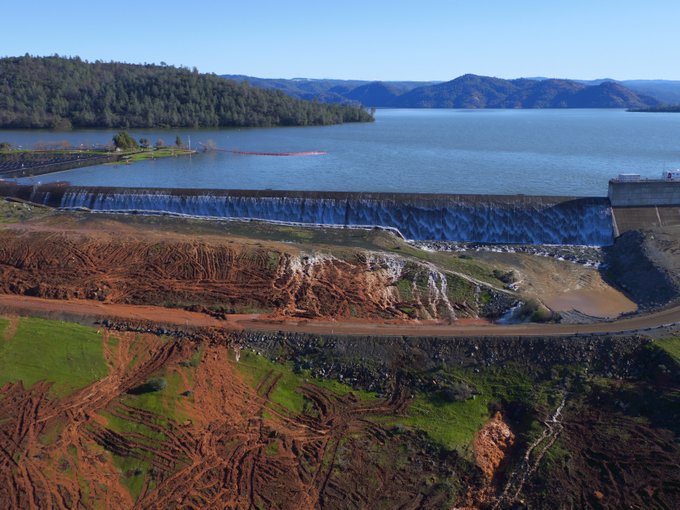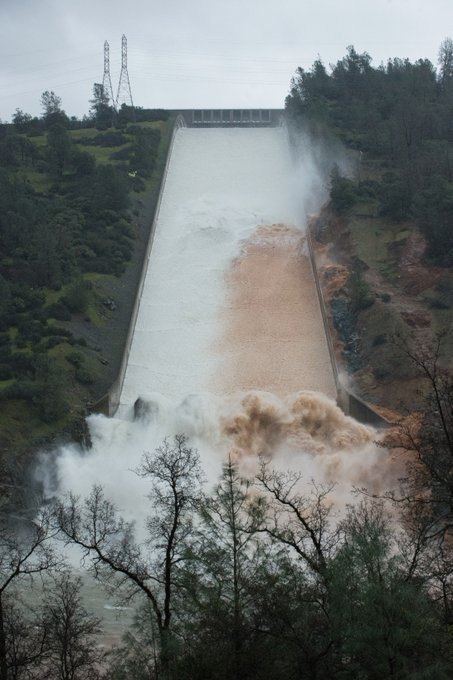by Deirdre Des Jardins, California Water Research
Major concerns about the deficiencies and risks of Oroville Dam’s auxiliary spillway and flood control operations were raised by American Rivers, the California Sportfishing Protection Alliance, Friends of the River (FOR), the Sierra Club, the South Yuba River Citizen’s League (SYRCL) and Sutter County during FERC relicensing of Oroville, 12 years before the crisis began at Oroville Dam when a giant hole developed in the spillway on February 7.

The issues have not been resolved. In 2005, Friends of the River, the Sierra Club, and the South Yuba River Citizen’s League filed a motion to intervene on the behalf of members that live or reside behind the levees on the Feather River. This briefing is based on that filing.
Oroville Dm includes two spillways, the main spillway (controlled by gates) and an ungated, unarmored auxiliary spillway, consisting of a 1,730 ft long spillway lip at an elevation of 901 feet, which spills directly onto the hillside.
When the Oroville reservoir levels rise above 901 feet, the auxiliary spillway begins to spill. At that level, the Army Corps of Engineers’ regulation manual
prescribes “objective” releases of a total of 150,000 cfs through both spillways.
Risks in using the emergency spillway: In 2002, Yuba County Water Agency explained the damage that could occur if the unarmored auxiliary spillway is used:

“The hillside between the emergency spillway and the Feather River would be subject to severe erosion when water flows over the spillway. Depending on the rate of flow, the erodable area . . . could range from 50 to 70 acres. The amount of soil, rock, and debris that would fall into the Feather River could be very large, depending on the depth of erosion. There could be damages to downstream structures, including the Thermalito Diversion mDam and Powerplant, Fish Barrier Dam, and highway bridges. If there is river channel mblockage below the spillway, there could be impacts on operation of Hyatt Powerplant.”
(YCWA, Technical Memorandum on Lake Oroville Surcharge, August 2002, p. IV-3)
To protect the levees downstream, the Army Corps allows no more than 150,000 cfs to be released from Oroville, and mandates that Feather River flows not exceed 300,000 cfs below the mouth of Yuba River.
But if inflows are so large that the reservoir reaches 911 feet – 10 feet above the auxiliary spillway – the Emergency Spillway Release Diagram is followed, prescribing even greater releases to protect the dam.
In 2005, Sutter County requested that FERC direct that DWR “investigate the adequacy and structural integrity of the auxiliary spillway that posed a risk to project facilities and downstream levees in Sutter County” and “take all necessary actions to correct identified deficiencies.”
(Oroville Facilities – FERC Project No. 2100 EIS, p. C-21.) Sacramento Valley Flood Control System — Channel Capacity in cfs (cubic feet per second) DWR, 1997)
Friends of the River also raised concerns with FERC that use of the emergency spillway could cause a loss of crest control at the dam:
“A single operational use or multiple operational uses (with failure to repair any preceding or cumulative damage) of the ungated spillway could result in a loss of crest control of Oroville Dam. A loss of crest control could not only cause additional damage to project lands and facilities but also cause damages and threaten lives in the protected floodplain downstream. An unarmored spillway is not in conformance with current FERC engineering regulations.”
DWR’s response to concerns: In response, the Department of Water Resources denied there was a risk of loss of crest control if the emergency spillway was used, but did not provide any geotechnical information to verify the claim. DWR also argued that a feasibility study of armoring the emergency spillway should be financed as a flood control project by the Army Corps of Engineers.
DWR has not requested a feasibility study by the Corps for armoring the spillway, and the project is unlikely to be eligible for funding as an Army Corps of Engineers flood control project because DWR has the obligation of controlling releases from the dam.
Ron Stork, Senior Policy Analyst at Friends of the River, contributed to this summary.
